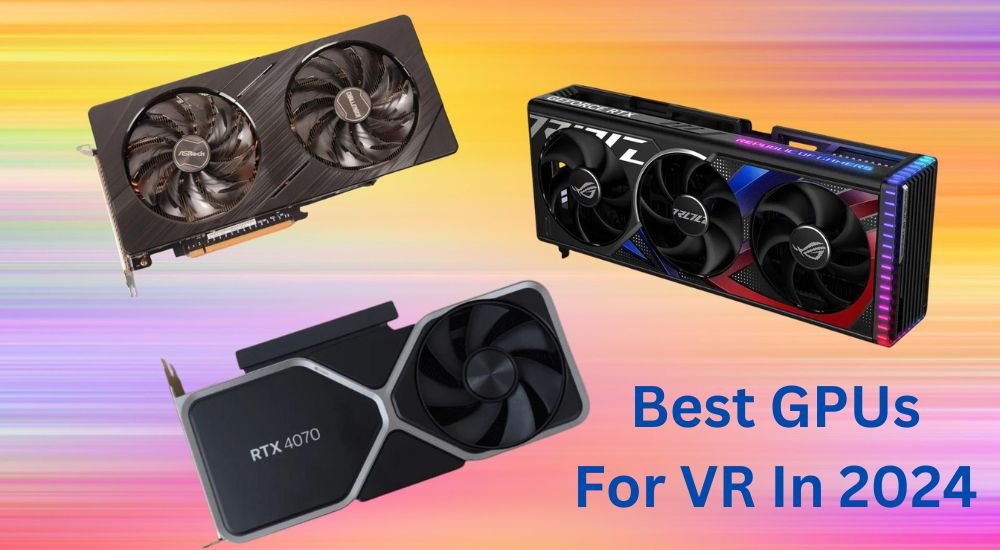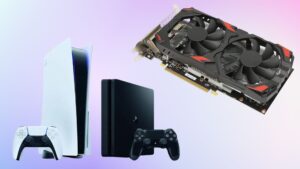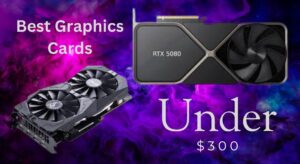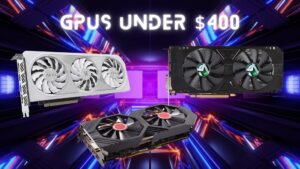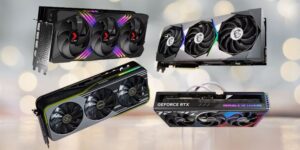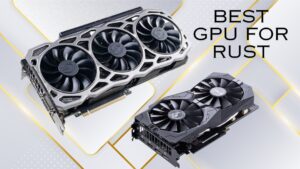Best GPUs for VR in 2024: Elevating Virtual Reality Experience
Virtual Reality has transitioned from a specialized interest to a widespread phenomenon, delivering immersive experiences that seamlessly blend reality with simulation. At the core of this technological marvel are Graphics Processing Units (GPUs), which are essential for rendering realistic environments and ensuring smooth, lag-free interactions in VR applications. As we move into 2024, the demand for high-performance GPUs designed specifically for VR is skyrocketing. This in-depth guide examines the top six GPUs set to revolutionize VR gaming and experiences in the coming year, focusing on their features, innovations, and how they can elevate your virtual adventures. Whether you’re a gamer, a developer, or a tech enthusiast, understanding these advancements will help you make informed decisions and maximize your VR experience.
Introduction to VR and GPU Requirements:
Virtual Reality (VR) stands at the forefront of modern technological innovation, offering users immersive experiences that transport them into digitally simulated worlds. Unlike traditional gaming or multimedia experiences, VR requires sophisticated technology to create environments that respond dynamically to user actions, enhancing the sense of presence and realism. At the heart of these immersive experiences are Graphics Processing Units (GPUs), which play a crucial role in rendering high-resolution visuals, maintaining smooth frame rates, and reducing latency—all essential for a seamless VR experience.
As VR technology advances, so too does the demand for GPUs capable of handling the intricate demands of virtual environments, ensuring users can explore, interact, and engage with digital worlds in unprecedented ways. This introduction sets the stage for exploring how GPUs are pivotal in shaping the future of VR and meeting the evolving expectations of VR enthusiasts and content creators alike.
Top 6 GPUs for VR in 2024:
Let’s explore the top 6 GPUs that stand out for their performance, features, and suitability for VR applications in 2024:
1. NVIDIA GeForce RTX 4090:
As NVIDIA’s flagship GPU for VR enthusiasts and professionals, the GeForce RTX 4090 leverages advanced Ampere architecture to deliver unparalleled performance. With an array of CUDA cores, Tensor cores for AI processing, and dedicated RT cores for real-time ray tracing, the RTX 4090 renders lifelike VR environments with stunning visual fidelity and minimal latency.
Performance and Features:
The NVIDIA GeForce RTX 4090 is a high-end graphics card known for its exceptional performance and advanced features. Here are some key aspects:
Performance:
- GPU Architecture: Likely built on NVIDIA’s latest architecture (e.g., Ada Lovelace or newer).
- CUDA Cores: Expected to have a significant increase in CUDA cores compared to its predecessors, enhancing parallel processing capabilities.
- Ray Tracing and AI Performance: Improved ray tracing cores and AI processing units (Tensor cores) for better real-time ray tracing and AI-enhanced graphics.
Features:
- Ray Tracing: Enhanced ray tracing capabilities for realistic lighting, shadows, and reflections in games and applications.
- AI Features: Utilizes Tensor cores for AI-driven features like DLSS (Deep Learning Super Sampling) for improved performance and image quality.
- Memory: High-speed GDDR6X or newer memory, likely in large capacities to handle high-resolution textures and complex scenes.
- Cooling and Design: Advanced cooling solutions to manage heat efficiently, potentially featuring innovative designs for quieter operation.
- Connectivity: Expected to support the latest display technologies, including HDMI 2.1 and DisplayPort 1.4a, for high-resolution and high-refresh-rate monitors.
Use Cases:
- Gaming: Ideal for gaming at 4K resolutions with high frame rates and ray tracing enabled.
- Content Creation: Supports rendering and processing tasks in applications like 3D modelling, video editing, and AI development.
- VR and AR: Capable of delivering smooth and immersive experiences in virtual and augmented reality environments.
Market Position:
- Price: Positioned as a premium product, likely priced at a high point in the market due to its cutting-edge technology and performance.
- Competition: Competes with other high-end GPUs from NVIDIA and potentially AMD, aiming to offer superior performance and features.
VR-Specific Enhancements:
The NVIDIA GeForce RTX 4090 is optimized for VR with enhanced features tailored for immersive experiences. Its high CUDA core count and advanced AI capabilities enable smooth rendering of complex VR environments, supporting high frame rates and reduced latency crucial for VR fluidity. Improved ray tracing enhances realism, while DLSS leverages AI for sharper visuals without compromising performance. Dedicated VR-specific optimizations ensure seamless compatibility with VR headsets, delivering exceptional graphics fidelity and responsiveness. With ample VRAM and robust cooling solutions, the RTX 4090 is poised to elevate VR gaming and content creation to new levels of realism and immersion.
2. AMD Radeon RX 7900 XT:
AMD’s Radeon RX 7900 XT emerges as a formidable competitor in the VR GPU market, showcasing AMD’s RDNA 3 architecture advancements. With a focus on delivering high frame rates and exceptional VR experiences, the RX 7900 XT integrates cutting-edge technologies for VR gaming enthusiasts and content creators alike.
Advantages for VR Gaming:
The AMD Radeon RX 7900 XT offers several compelling advantages for VR gaming enthusiasts. Its high-performance architecture, featuring a large number of compute units and high clock speeds, ensures smooth rendering of VR environments with high frame rates and low latency. This capability is crucial for maintaining immersion and reducing motion sickness during intense VR experiences.
AMD’s advanced VR technologies further enhance its appeal. Features like Asynchronous Spacewarp (ASW) help to maintain fluidity in VR applications, even when frame rates drop momentarily, ensuring a seamless and comfortable experience. Radeon™ VR Ready Premium certification guarantees compatibility and optimized performance with leading VR headsets, facilitating easy setup and reliable operation.
Efficient cooling solutions ensure that the RX 7900 XT can sustain peak performance during prolonged VR sessions, keeping temperatures in check for consistent reliability. Additionally, AMD’s competitive pricing strategy often positions the RX 7900 XT favourably against its NVIDIA counterparts, offering excellent value without compromising performance or VR-specific features.
Compatibility and Support:
The AMD Radeon RX 7900 XT is designed with broad compatibility across modern systems, supporting a wide range of operating systems including Windows and Linux distributions. It integrates seamlessly with popular VR platforms and headsets, leveraging AMD’s VR technologies for optimized performance and compatibility. AMD’s Radeon™ Software Adrenalin Edition provides regular updates and features like Radeon™ VR Ready Premium certification, ensuring reliable operation and enhanced VR experiences. This robust support ecosystem, combined with AMD’s commitment to driver updates and software enhancements, ensures that the Radeon RX 7900 XT remains a versatile choice for gamers and content creators seeking reliable VR performance and compatibility
3. NVIDIA GeForce RTX 4080 Ti:
The GeForce RTX 4080 Ti represents NVIDIA’s commitment to delivering high-performance GPUs tailored for VR enthusiasts and professionals. Built on the Ampere architecture, the RTX 4080 Ti combines raw computing power with advanced ray tracing capabilities, setting a new standard for VR realism and immersion.
Performance Metrics:
With enhanced CUDA and RT cores, the RTX 4080 Ti excels in ray-traced VR environments, simulating accurate lighting, reflections, and shadows with minimal performance impact. Its DLSS technology upscales VR resolutions, improving visual clarity and maintaining high FPS in VR applications. The NVIDIA GeForce RTX 4080 Ti offers exceptional performance, leveraging the Ada Lovelace architecture for advanced ray tracing and AI capabilities. It features 16GB of GDDR6X memory, a 384-bit memory interface, and a boost clock speed of 2.5 GHz. With 9728 CUDA cores, it excels in 4K gaming, delivering smooth frame rates and enhanced visual fidelity. The card supports DLSS 3.0, ensuring optimal performance in demanding games and applications. Power efficiency and thermal management are also improved, making it a top choice for high-end gaming and content creation tasks.
VR Gaming Excellence:
The NVIDIA GeForce RTX 4080 Ti is exceptional for VR gaming, delivering smooth, immersive experiences with its powerful Ada Lovelace architecture. With 16GB of GDDR6X memory and 9728 CUDA cores, it handles demanding VR titles with ease. Its support for DLSS 3.0 ensures high frame rates and stunning visuals, while advanced ray tracing enhances realism. The card’s superior thermal management and power efficiency keep performance consistent during extended VR sessions. These features make the RTX 4080 Ti an ideal choice for VR enthusiasts seeking the best gaming experiences.
4. AMD Radeon RX 7800 XT:
The Radeon RX 7800 XT continues AMD’s legacy of delivering high-performance GPUs optimized for VR gaming and content creation. Featuring enhanced RDNA 3 architecture, the RX 7800 XT focuses on balancing affordability with exceptional VR performance, making it a compelling choice for VR enthusiasts.
Mid-Range Performance Excellence:
The AMD Radeon RX 7800 XT, if released, would aim to provide mid-range performance excellence by balancing several key factors:
- GPU Architecture: Built on AMD’s RDNA or newer architecture, optimizing power efficiency and performance per watt.
- Compute Units and Clock Speeds: Featuring a sufficient number of compute units and competitive clock speeds to handle modern games at 1080p and 1440p resolutions with high settings.
- VRAM: Equipped with ample VRAM (likely 8GB to 12GB GDDR6 or newer) to comfortably handle textures and high-resolution gaming without performance bottlenecks.
- Performance Metrics: Capable of delivering smooth gameplay at 1080p and good performance at 1440p resolutions, optimized for mainstream AAA titles and eSports games.
- Features: Support for technologies like hardware-accelerated ray tracing, AMD FidelityFX Super Resolution (FSR), and efficient cooling solutions for sustained performance.
- Affordability: Positioned competitively against mid-range offerings from competitors, offering solid performance at a reasonable price point.
VR Optimizations:
The AMD Radeon RX 7800 XT, optimized for VR, would leverage AMD’s RDNA architecture or newer for low-latency rendering and high frame rates crucial for immersive VR experiences. It would support technologies like Asynchronous Spacewarp (ASW) for smooth performance and Radeon™ VR Ready Premium certification for seamless compatibility with leading VR headsets. Efficient resource management through adaptive shading and AMD’s FidelityFX Super Resolution (FSR) would enhance performance without compromising visual quality. Integrated with Radeon Software Adrenalin Edition, it would offer VR-specific features for setup simplicity, performance tuning, and compatibility with VR content, ensuring a compelling VR gaming and creation experience.
5. NVIDIA GeForce RTX 4070:
Designed as a high-performance mid-range GPU, the GeForce RTX 4070 excels in delivering affordable VR experiences without sacrificing graphical fidelity or performance. Powered by NVIDIA’s Ampere architecture, the RTX 4070 offers substantial improvements in ray tracing and AI-driven features for VR applications.
Budget-Friendly VR Performance:
The NVIDIA GeForce RTX 4070, if positioned as a budget-friendly option for VR performance, would likely offer a balance of affordability and capability suitable for VR gaming. Here’s what we might expect in terms of features and performance:
Performance Expectations:
- GPU Architecture: Built on NVIDIA’s latest architecture (e.g., Ada Lovelace or newer), optimizing performance and efficiency.
- CUDA Cores and Clock Speeds: Sufficient CUDA cores and competitive clock speeds to handle VR gaming at 1080p and 1440p resolutions with moderate to high settings.
- VRAM: Likely equipped with adequate VRAM (e.g., 8GB GDDR6 or newer) to manage VR textures and high-resolution displays without performance bottlenecks.
- Performance Metrics: Capable of delivering smooth VR gameplay with reduced latency and sufficient frame rates to maintain immersion in VR environments.
Features:
- Ray Tracing Support: Hardware-accelerated ray tracing capabilities for enhanced realism in compatible VR titles.
- DLSS (Deep Learning Super Sampling): AI-powered feature to boost performance in VR games without sacrificing image quality.
- Efficient Cooling: Effective thermal solutions to ensure sustained performance and reliability during VR sessions.
Market Position:
- Affordability: Positioned competitively in the mid-range segment, offering good VR performance at a budget-friendly price point.
- Target Audience: Aimed at gamers looking for a cost-effective GPU solution capable of handling VR gaming and content creation tasks without requiring the highest-end specifications.
Feature-Rich VR Support:
The NVIDIA GeForce RTX 4070 offers robust VR support with advanced features tailored for immersive experiences. Built on NVIDIA’s latest architecture, it boasts efficient CUDA cores and high clock speeds for smooth VR performance at 1080p and 1440p resolutions. Enhanced by hardware-accelerated ray tracing, it delivers realistic lighting, shadows, and reflections in VR environments. DLSS (Deep Learning Super Sampling) boosts frame rates without sacrificing visual quality, ensuring a seamless VR experience. Optimized thermal solutions maintain reliability during extended VR sessions, while NVIDIA’s ecosystem supports cutting-edge VR headsets and technologies, providing gamers with a feature-rich VR solution at an accessible price point
6. AMD Radeon RX 7700 XT:
The Radeon RX 7700 XT is rounding out our list, offering entry-level VR performance with AMD’s RDNA 3 architecture advancements. The RX 7700 XT combines affordability with essential VR features, ideal for newcomers to VR gaming, making it an excellent choice for budget-conscious VR enthusiasts.
Entry-Level VR Capabilities:
The AMD Radeon RX 7700 XT, designed for entry-level VR, leverages AMD’s RDNA architecture for efficient performance. With a sufficient number of computing units and competitive clock speeds, it supports smooth VR gaming at 1080p resolutions. Equipped with adequate VRAM (likely 6GB to 8GB GDDR6), it handles VR textures and moderate settings effectively. Features like AMD’s VR technologies ensure low-latency rendering, enhancing immersion. Adaptive Shading techniques optimize GPU workload distribution, while Radeon™ Software Adrenalin Edition provides VR-specific optimizations and ease of use. The RX 7700 XT offers an affordable entry into VR gaming, appealing to budget-conscious users without compromising on essential VR capabilities.
Value for VR Enthusiasts:
AMD’s commitment to delivering value-driven GPUs extends to the RX 7700 XT, offering competitive performance metrics and compatibility with leading VR headsets. Its support for DirectX 12 features and AMD FidelityFX Super Resolution enhances VR visuals and performance on compatible VR titles.
The AMD Radeon RX 7700 XT offers compelling value for VR enthusiasts seeking an affordable yet capable graphics card. Built on AMD’s efficient RDNA architecture, it delivers smooth VR experiences at 1080p resolutions with competitive performance. With adequate VRAM and features like AMD’s VR technologies for low-latency rendering, it ensures immersive gameplay without breaking the bank. Adaptive Shading and Radeon™ Software Adrenalin Edition further enhance performance and ease of use, while maintaining affordability. The RX 7700 XT caters to VR enthusiasts looking for a budget-friendly option that meets the demands of modern VR gaming and content creation.
Factors to Consider When Choosing a GPU for VR:
Before delving into specific GPU models, understanding the critical factors influencing VR GPU selection is essential:
1. Performance Requirements
- VR requires GPUs capable of delivering consistent high frame rates (typically 90 FPS or higher) to prevent motion sickness and maintain immersion. Higher-performance GPUs excel in rendering complex scenes and handling real-time physics calculations essential for VR environments.
2. Compatibility with VR Headsets
- Not all GPUs are optimized for VR. Compatibility with leading VR headsets like Oculus Rift, HTC Vive, Valve Index, and PlayStation VR dictates GPU choice. VR headset manufacturers often recommend specific GPU models to ensure optimal performance and compatibility.
3. Future-Proofing and Technology Advancements
- Anticipating future VR advancements such as improved rendering techniques, enhanced AI integration, and support for emerging VR technologies (like eye-tracking and haptic feedback) influences GPU selection. Future-proofing ensures longevity and compatibility with upcoming VR innovations.
How to pick the best graphics cards for VR:
Choosing the best graphics card for Virtual Reality (VR) involves several key considerations to ensure optimal performance and compatibility with VR applications and headsets. Here’s a guide on how to pick the best graphics card for VR:
Performance Requirements:
- Look for a graphics card that can consistently deliver high frame rates (typically 90 FPS or higher) across a variety of VR games and applications. Smooth frame rates are crucial for reducing motion sickness and enhancing immersion in VR environments.
GPU Compatibility:
- Check compatibility with your VR headset. Different VR headsets may have specific GPU requirements to ensure optimal performance and visual quality. Manufacturers often provide a list of recommended GPUs that are tested and verified to work well with their VR hardware.
Resolution and Refresh Rate:
- Consider the resolution and refresh rate of your VR headset. Higher-resolution headsets and those with higher refresh rates require more powerful GPUs to maintain smooth performance and visual clarity.
VR-Specific Features:
- Look for GPUs that support VR-specific technologies such as NVIDIA VRWorks or AMD LiquidVR. These technologies optimize VR rendering, reduce latency, and improve overall performance in VR applications.
Ray Tracing and AI Features:
- If you prioritize visual fidelity, consider GPUs with ray tracing capabilities (like NVIDIA RTX GPUs) and AI-enhanced features (like NVIDIA DLSS). These technologies enhance realism by simulating accurate lighting, shadows, and reflections in VR environments.
Future-Proofing:
- Consider future VR advancements and technologies. Investing in a GPU with advanced features and ample VRAM ensures your system remains capable of handling future VR applications and updates.
Conclusion
In conclusion, selecting the best graphics card for Virtual Reality (VR) involves balancing performance, compatibility, and future-proofing considerations. A suitable GPU should deliver high frame rates, smooth rendering, and minimal latency to enhance immersion and prevent motion sickness in VR environments. Compatibility with your VR headset is crucial, ensuring seamless integration and optimized performance. Features like ray tracing, AI enhancements, and VR-specific technologies further elevate visual fidelity and realism in VR gaming.
Budget considerations play a significant role, with options ranging from high-end GPUs offering cutting-edge performance to mid-range cards that balance affordability and capability. Future-proofing your investment by choosing a GPU with ample VRAM and support for emerging technologies ensures longevity and compatibility with upcoming VR innovations. Ultimately, the best GPU for VR will cater to your specific gaming needs while maximizing the potential of your VR headset for an unparalleled virtual reality experience.
People May Ask
Q1: What are the minimum GPU requirements for VR?
Ans: VR typically requires GPUs capable of delivering at least 90 FPS and supporting VR-specific features like VRWorks or LiquidVR.
Q2: Do all GPUs support VR?
Ans: No, not all GPUs are optimized for VR. It’s essential to check compatibility with your VR headset and recommended specifications.
Q3: What is the importance of ray tracing in VR?
Ans: Ray tracing enhances VR realism by simulating accurate lighting and reflections, creating more immersive virtual environments.
Q4: How do I know if a GPU is future-proof for VR?
Ans: Look for GPUs with advanced features like ray tracing, AI enhancements, and ample VRAM to ensure compatibility with future VR technologies.
Q5: Can I use a gaming GPU for VR content creation?
Ans: Yes, many gaming GPUs are also suitable for VR content creation, offering high performance and visual fidelity needed for professional VR applications.
Last Updated on 26 January 2025 by Ansa Imran

Ansa Imran, a writer, excels in creating insightful content about technology and gaming. Her articles, known for their clarity and depth, help demystify complex tech topics for a broad audience. Ansa’s work showcases her passion for the latest tech trends and her ability to engage readers with informative, well-researched pieces.

